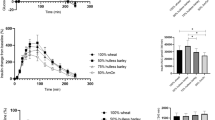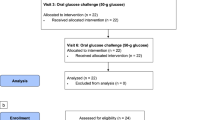Abstract
Background/objectives
The amylose-amylopectin ratio influences starch properties. A higher amylose content is associated with slower starch digestion thus reducing the postprandial plasma glucose response and improving the overall postprandial metabolism. So far, limited evidence is available on the metabolic effect of wheat-based foods rich in amylose. This randomised controlled study investigated the acute metabolic effects of amylose-rich wheat-based rusks in overweight subjects focusing on potential mechanisms.
Subjects/methods
Ten overweight subjects consumed in random order two test meals differing only in the carbohydrate source: rusks prepared with amylose-rich wheat flour (ARR) or conventional wheat flour (control). Blood samples were taken at fasting and over 4 h after the meal. Satiety and intestinal fermentation were evaluated by VAS and H2-breath test, respectively.
Results
ARR reduced plasma glucose response during the first two hours after the meal and the desire to eat, and increased breath hydrogen concentration at 4 h (p < 0.05 for all). Moreover, according to computational models, the ARR slightly reduced intestinal glucose absorption in the first hour after the meal and increased the overall postprandial insulin sensitivity.
Conclusions
Rusks made with amylose-rich flour could be useful for improving postprandial glucose metabolism and reduce the desire to eat, thus possibly contributing to the prevention and treatment of overweight/obesity, impaired glucose tolerance or diabetes.
This is a preview of subscription content, access via your institution
Access options
Subscribe to this journal
Receive 12 print issues and online access
$259.00 per year
only $21.58 per issue
Buy this article
- Purchase on SpringerLink
- Instant access to full article PDF
Prices may be subject to local taxes which are calculated during checkout



Similar content being viewed by others

References
van Bakel MM, Kaaks R, Feskens EJ, Rohrmann S, Welch AA, Pala V, et al. Dietary glycaemic index and glycaemic load in the European Prospective Investigation into Cancer and Nutrition. Eur J Clin Nutr. 2009;63(Suppl 4):188–205.
Järvi AE, Karlström BE, Granfeldt YE, Björck IM, Vessby BO, Asp NG. The influence of food structure on postprandial metabolism in patients with non-insulin-dependent diabetes mellitus. Am J Clin Nutr. 1995;61:83742.
Livesey G, Taylor R, Hulshof T, Howlett J. Glycemic response and health—a systematic review and meta-analysis: relations between dietary glycemic properties and health outcomes. Am J Clin Nutr. 2008;87:S258–68.
Bhupathiraju SN, Tobias DK, Malik VS, Pan A, Hruby A, Manson JE, et al. Glycemic index, glycemic load, and risk of type 2 diabetes: results from 3 large US cohorts and an updated meta-analysis. Am J Clin Nutr. 2014;100:218–32.
Parillo M, Annuzzi G, Rivellese AA, Bozzetto L, Alessandrini R, Riccardi G, et al. Effects of meals with different glycaemic index on postprandial blood glucose response in patients with Type 1 diabetes treated with continuous subcutaneous insulin infusion. Diabet Med. 2011;28:227–9.
Turati F, Galeone C, Gandini S, Augustin LS, Jenkins DJA, Pelucchi C, et al. High glycemic index and glycemic load are associated with moderately increased cancer risk. Mol Nutr Food Res. 2015;59:1384–94.
Augustin LS, Kendall CW, Jenkins DJ, Willett WC, Astrup A, Barclay AW, et al. Glycemic index, glycemic load and glycemic response: An International Scientific Consensus Summit from the International Carbohydrate Quality Consortium (ICQC). Nutr Metab Cardiovasc Dis. 2015;25:795–815.
Eelderink C, Noort MWJ, Sozer N, Koehorst M, Holst JJ, Deacon CF, et al. Difference in postprandial GLP-1 response despite similar glucose kinetics after consumption of wheat breads with different particle size in healthy men. Eur J Nutr. 2017;56:1063–76.
Riccardi G, Rivellese AA, Giacco R. Role of glycemic index and glycemic load in the healthy state, in prediabetes, and in diabetes. Am J Clin Nutr. 2008;87:269S–74S.
Rivellese AA, Giacco R, Costabile G. Dietary carbohydrates for diabetics. Curr Atheroscler Rep. 2012;14:563–9.
Cust AE, Skilton MR, van Bakel MM, Halkjaer J, Olsen A, Agnoli C, et al. Total dietary carbohydrate, sugar, starch and fibre intakes in the European Prospective Investigation into Cancer and Nutrition. Eur J Clin Nutr. 2009;63:S37–60.
Birt DF, Boylston T, Hendrich S, Jane JL, Hollis J, Li L, et al. Resistant starch: promise for improving human health. Adv Nut. 2013;4:587–601.
Granfeldt Y, Liljeberg H, Drews A, Newman R, Björck I. Glucose and insulin responses to barley products: influence of food structure and amylose-amylopectin ratio. Am J Clin Nutr. 1994;59:1075–82.
Keogh JB, Lau CW, Noakes M, Bowen J, Clifton PM. Effects of meals with high soluble fibre, high amylose barley variant on glucose, insulin, satiety and thermic effect of food in healthy lean women. Eur J Clin Nutr. 2007;61:597–604.
Goddard MS, Young G, Marcus R. The effect of amylose content on insulin and glucose responses to ingested rice. Am J Clin Nutr. 1984;39:388–92.
Zenel AM, Stewart ML. High amylose white rice reduces post-prandial glycemic response but not appetite in humans. Nutrients. 2015;7:5362–74.
Behall KM, Scholfield DJ, Yuhaniak I, Canary J. Diets containing high amylose vs amylopectin starch: effects on metabolic variables in human subjects. Am J Clin Nutr. 1989;49:337–44.
Behall KM, Howe JC. Effect of long-term consumption of amylose vs amylopectin starch on metabolic variables in human subjects. Am J Clin Nutr. 1995;61:334–40.
Behall KM, Hallfrisch J. Plasma glucose and insulin reduction after consumption of breads varying in amylose content. Eur J Clin Nutr. 2002;56:913–20.
Hallström E, Sestili F, Lafiandra D, Björck I, Ostman E A novel wheat variety with elevated content of amylose increases resistant starch formation and may beneficially influence glycaemia in healthy subjects. Food Nutr Res 2011; 55. https://doi.org/10.3402/fnr.v55i0.7074.
Rahman S, Bird A, Regina A, Li Z, Ral JP, McMaugh S, et al. Resistant starch in cereals: exploiting genetic engineering and genetic variation. J Cereal Sci. 2007;46:251–60.
Botticella E, Sestili F, Ferrazzano G, Mantovani P, Cammerata A, D’Egidio MG, et al. The impact of the SSIIa null mutations on grain traits and composition in durum wheat. Breed Sci. 2016;66:572–79.
Sestili F, Palombieri S, Botticella E, Mantovani P, Bovina R, Lafiandra D. TILLING mutants of durum wheat result in a high amylose phenotype and provide information on alternative splicing mechanisms. Plant Sci. 2015;233:127–33.
Raben A, Tagliabue A, Astrup A. The reproducibility of subjective appetite scores. Br J Nutr. 1995;73:517–30.
Ibrügger S, Vigsnæs LK, Blennow A, Skuflić D, Raben A, Lauritzen L, et al. Second meal effect on appetite and fermentation of wholegrain rye foods. Appetite. 2014;80:248–56.
Botticella E, Sestili F, Hernandez-Lopez A, Phillips A, Lafiandra D. High Resolution Melting analysis for the detection of EMS induced mutations in wheat SbeIIa genes. BMC Plant Biol. 2011;11:156.
Giacco R, Costabile G, Della Pepa G, Anniballi G, Griffo E, Mangione A, et al. A whole-grain cereal-based diet lowers postprandial plasma insulin and triglyceride levels in individuals with metabolic syndrome. Nutr Metab Cardiovasc Dis. 2014;24:837–44.
Di Marino L, Griffo E, Maione S, Mirabella M. Active glucagon-like peptide-1 (GLP-1): storage of human plasma and stability over time. Clin Chim Acta. 2011;412:1693–4.
Matsuda M, DeFronzo RA. Insulin sensitivity indices obtained from oral glucose tolerance testing: comparison with the euglycemic insulin clamp. Diabetes Care. 1999;22:1462–70.
Anderwald C, Gastaldelli A, Tura A, Krebs M, Promintzer-Schifferl M, Kautzky-Willer A, et al. Mechanism and effects of glucose absorption during an oral glucose tolerance test among females and males. J Clin Endocrinol Metab. 2011;96:515–24.
Morbiducci U, Di Benedetto G, Kautzky-Willer A, Deriu MA, Pacini G, Tura A. Identification of a model of non-esterified fatty acids dynamics through genetic algorithms: the case of women with a history of gestational diabetes. Comput Biol Med. 2011;41:146–53.
Woerdeman J, Del Rio D, Calani L, Eringa EC, Smulders YM, Serné EH. Red wine polyphenols do not improve obesity-associated insulin resistance: a randomized controlled trial. Diabetes Obes Metab. 2017;20:206–10. https://doi.org/10.1111/dom.13044
Pollack RM, Barzilai N, Anghel V, Kulkarni AS, Golden A, O’Broin P. et al. Resveratrol improves vascular function and mitochondrial number but not glucose metabolism in older adults. J Gerontol A Biol Sci Med Sci. 2017;72:1703–9.
Kitaoka K, Takeuchi M, Tsuboi A, Minato S, Kurata M, Tanaka S. et al. Increased adipose and muscle insulin sensitivity without changes in serum adiponectin in young female collegiate athletes. Metab Syndr Relat Disord. 2017;15:246–51.
Morandi A, Fornari E, Opri F, Corradi M, Tommasi M, Bonadonna R. et al. High-fat meal, systemic inflammation and glucose homeostasis in obese children and adolescents. Int J Obes (Lond). 2017;41:986–9.
Robertson DM. Metabolic cross talk between the colon and the periphery: Implications for insulin sensitivity. Proc Nutr Soc. 2007;66:351–61.
Nilsson A, Ostman E, Preston T, Björck I. Effects of GI vs content of cereal fibre of the evening meal on glucose tolerance at a subsequent standardized breakfast. Eur J Clin Nutr. 2008;62:712–20.
Acknowledgements
We gratefully acknowledge Barilla for manufacturing test products, and Dr Angela Giacco for skilful dietary assistance.
Author information
Authors and Affiliations
Corresponding author
Ethics declarations
Conflict of interest
The authors declare that they have no conflict of interest.
Rights and permissions
About this article
Cite this article
Vetrani, C., Sestili, F., Vitale, M. et al. Metabolic response to amylose-rich wheat-based rusks in overweight individuals. Eur J Clin Nutr 72, 904–912 (2018). https://doi.org/10.1038/s41430-018-0136-8
Received:
Revised:
Accepted:
Published:
Issue Date:
DOI: https://doi.org/10.1038/s41430-018-0136-8
This article is cited by
-
Cibi per diabetici. Che senso ha?
L'Endocrinologo (2019)


